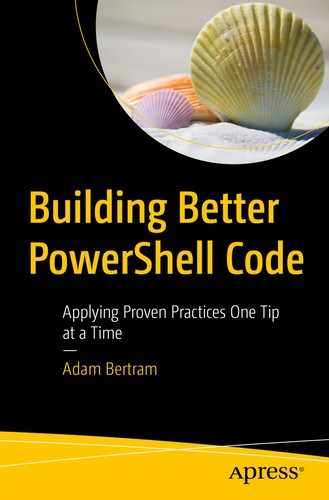You can write code all day to solve all the things, but if you can’t manage it over time, you’re sunk. It’s important to not only solve the problems of today but think about how those solutions will be maintained over time.
DRY: Don’t Repeat Yourself
Notice when you’re repeating the same code snippets. Be cognizant you’re following the same patterns over and over again. Being great at coding is about pattern recognition and improving efficiency.
Don’t type out the same command ten times to process ten different parameter values. Use a loop. Write “helper” functions that can be called from other functions to eliminate writing that same code again.
Not only is the code much shorter, it’s also much more manageable in the future. To add new features, simply add them to the $featureNames array. To change the behavior of find the status or installing a new feature, just change the code inside of the foreach loop.
The preceding example is only one way to implement the DRY mentality. Be constantly looking for repeating patterns and address them using logic.
Further Learning
Don’t Store Configuration Items in Code
Always treat configuration items that are required in your code as separate entities. Items like usernames, passwords, API keys, IP addresses, hostnames, etc. are all considered configuration items. Configuration items should then be pointed to in your code. These artifacts are static values that should be injected in your code, not stored in the code.
Separating out configuration items from your code allows you the code to be more flexible. It allows you to make a change at a global level and that change be immediately consumed by the code.
Whenever you write PowerShell code, you should always build with reuse in mind. Storing configuration items outside of the code is one way to do that. Taking the previous tip “DRY: Don’t Repeat Yourself” to the next level, let’s build that code using a configuration file.
Instead of defining the items that may change over time (Windows feature names) inside of the code as is, store them in an external data store. This kind of data store can be anything like a JSON, XML, YAML, or even a SQL database. The point is to separate the data from the code logic itself.
This practice sets up your script for other configuration values down the road and even allow non-developers to easily change the behavior of the script simply by adding or removing Windows features in the configuration file.
Further Learning
Always Remove Dead Code
Although not critical, leaving code in scripts that will never be executed is bad practice. It clutters up the important code and makes it harder to understand and troubleshoot scripts. Remove it.
Look into using the code coverage options in Pester to discover all of the unused code in your scripts. If you’re using Visual Studio Code with the PowerShell extension, you can also spot and remove dead code by paying attention to unused variables.
Perhaps you have a script that connects to a remote computer. At the time you built it, your test computer was not in an Active Directory domain and you had to pass a PSCredential object to the remote computer. To support that use case, you added a Credential parameter. But things have changed, and this script is only used in a domain environment without needing an alternate credential.
The preceding code has two pieces of “dead” code: the Credential parameter and the $someLostForgottenVariable variable . Why is this code “dead”? Because it will never be used in the script. You can invoke the script using the Credential parameter, but it’s not going to be used. Also, as is, with the value of $someLostForgottenVariable set statically to bar, the Write-Host 'do something else here' line will never execute because it’s depending on a value that will never be set.
Tip Source: https://twitter.com/JimMoyle
